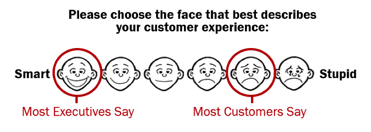A few years ago, Bain and Company published the results of a survey in conducted across a variety of industries. Their report illustrates a classic (and massive) customer experience disconnect. A full 80% of the firms surveyed believed that they delivered a “superior experience” to their customers. Yet when queried, their customers could hardly have been harsher. Only 8% believed that these companies delivered a superior experience.
 Today, there appears to be a big difference. Sadly, it’s less about the gap between what executives and customers believe, and more about the gap between what customers want and what executives actually give them.
Today, there appears to be a big difference. Sadly, it’s less about the gap between what executives and customers believe, and more about the gap between what customers want and what executives actually give them.
A recent CMO council survey tends to support this, with 73 percent of senior marketing executives stating that customer centricity is critical to the success of their business, but only 11 percent believing their customers would agree that they are.
The first step? Admitting you have a problem.
So where do you fit? There’s a 75 percent chance you agree that a customer focus is critical to your success. (And if you’re in the 25 percent that doesn’t think it’s important? Ha! Think again, buddy…). There’s also a high likelihood that you recognize you’re not giving your customers what they want. The good news is that first step in fixing any problem is in recognizing it exists. But that won’t fix it.
Looking at those companies who have been most successful at aligning their experience delivery with customer expectations, they had many things in common – these are three of the most relevant, and a great place to start if you’re trying to close your customer experience gaps:
- They design the right products, services and experiences for the right customers – with a focus on those customers who are both highly profitable, and who are most likely to be advocates.
- They focus the entire company on delivering these things, with an emphasis on cross-functional/cross-silo collaboration (for instance with marketing, sales, logistics, distribution, digital and IT all working together).
- They develop the ability to please these customers over and over again, by doing things like training and rewarding employees for doing so, continually improving underlying processes and systems, and establishing accountability for delivering the customer experience.
It comes down to this: In the context of your business model and the expectations your brand sets, understand what to your customers want and need from you, and see how well you’re doing at giving it to them. Then identify any gaps, and find ways to improve your performance in these areas.
At heart, “customer centricity” means putting your customers and their needs at the center of your organization – and consistently supporting that perspective with and through your people, your culture and the ways you do business. Do this well, and the only gaps you’ll be charting are the ones between you and your competition – as you leave them further and further behind.

